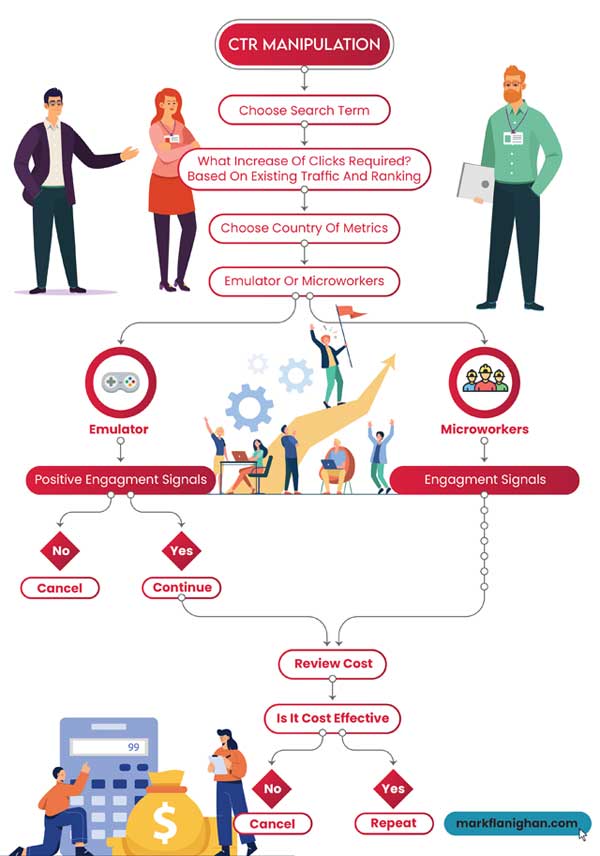Discover Our Expert CTR Manipulation Service for Enhanced Exposure
Discover Our Expert CTR Manipulation Service for Enhanced Exposure
Blog Article
Exactly How to Gauge the Effect of CTR Control on Your Advertising And Marketing
Comprehending the subtleties of click-through rate (CTR) adjustment in marketing is important for organizations striving for real user involvement. By analyzing vital metrics such as conversion rates and bounce prices, marketers can reveal potential inconsistencies that may develop from artificial enhancements.
Recognizing CTR Manipulation
Understanding CTR manipulation is crucial for marketing experts seeking to optimize their campaigns and guarantee data stability. Click-through rate (CTR) refers to the ratio of users who click on a specific link to the total number of users who see the ad or web content.
The implications of CTR manipulation prolong beyond plain information distortion; they can weaken count on in digital advertising. When businesses count on filled with air metrics, they might spend in inefficient campaigns, ultimately harming their return on investment. Additionally, systems might penalize advertisers taking part in such practices, leading to further implications for their marketing efforts.
To efficiently deal with CTR adjustment, marketing professionals have to develop a thorough understanding of their data resources and analytics tools. By using advanced tracking techniques and inspecting traffic resources, they can recognize irregular patterns and guarantee that their performance metrics reflect real user engagement - CTR Manipulation Press Release. This caution is important for cultivating long-lasting success in an increasingly affordable electronic landscape
Secret Metrics to Assess
Efficient evaluation of crucial metrics is vital for evaluating truth performance of advertising and marketing campaigns and detecting possible CTR control. One key statistics to consider is the Click-Through Price (CTR) itself, which represents the ratio of users that click an advertisement to the overall variety of users that watch it. A sudden spike in CTR may suggest adjustment, necessitating additional examination.
In addition, keeping an eye on conversion prices is necessary. A high CTR with a reduced conversion price could signal that the clicks are not authentic or that the targeting is misaligned (CTR Manipulation Press Release). Analyzing bounce rates can supply insight right into customer engagement; a high bounce price after a click might suggest that the website traffic is not quality-driven.

Tools for Measurement
.png)
In addition, A/B screening tools such as Optimizely or VWO can assist in trial and error with various ad variations to establish which elements drive higher CTR. These tools enable marketers to examine real-time efficiency and make data-driven adjustments. Social media site analytics devices, like Hootsuite or Sprout Social, can also contribute in recognizing best site CTR within social platforms, giving insights right into target market actions and interaction patterns.
In addition, warmth mapping devices, such as Hotjar, can reveal how individuals communicate with ads, assisting to determine where enhancements can be made. Integrating these tools develops a durable measurement framework, enabling marketing professionals to determine the impacts of CTR control successfully. Eventually, the best choice of measurement tools is crucial for making informed marketing decisions and maximizing project efficiency.

Examining Long-term Effects
One need to take into consideration the long-term impacts of CTR adjustment on overall advertising efficiency, as temporary gains can usually mask deeper ramifications. With time, unnaturally inflated click-through rates may bring about decreased trust from customers and online search engine alike. When individuals continuously run into deceitful techniques, they might come to be reluctant to involve with the brand name, resulting in reduced conversion rates in the future.
Furthermore, formula updates from platforms such as Google are made to prioritize real engagement over inflated metrics. Services that count on CTR manipulation may discover themselves punished, leading to Visit This Link a decrease in organic reach and exposure. This can have a cascading impact on brand name integrity and consumer commitment, ultimately weakening the extremely goals that the initial manipulation sought to achieve.
Additionally, the data collected from manipulated CTR may mislead online marketers in their technique advancement. Depending on manipulated information can result in misguided campaigns that stop working to resonate with the target market, leading to wasted sources and missed possibilities. It is vital for marketers to analyze the long-lasting implications of CTR control and focus on sustainable, moral interaction strategies for lasting success.
Moral Considerations in CTR Manipulation
In the realm of digital advertising and marketing, ethical considerations surrounding CTR control are extremely important. While the desire to enhance click-through rates (CTR) can lead to short-term gains, the prospective long-lasting effects on brand name integrity and consumer count on can not be neglected.
In addition, ethical issues include conformity with regulations such as the Federal Trade Commission (FTC) standards, which mandate transparency in advertising and marketing. Stopping working to abide by these requirements can subject services to lawful ramifications and harm their track record. Marketing experts have to take into consideration the effects of their techniques on individual experience and the broader industry landscape.
In addition, the increase of synthetic knowledge and automation in advertising presents additional ethical issues. Ultimately, moral advertising techniques must prioritize openness, honesty, and regard for the consumer, promoting long-term partnerships that transcend mere metrics like CTR.
Verdict
In conclusion, gauging the influence of CTR control on advertising needs an extensive analysis of essential metrics, including click-through rates, conversion rates, and bounce rates. Ultimately, a data-driven approach ensures that marketing approaches are reliable and straightened with real customer communications.
Recognizing go to my site the subtleties of click-through rate (CTR) manipulation in advertising and marketing is essential for services striving for real individual engagement.Reliable analysis of vital metrics is important for assessing the real performance of marketing projects and spotting possible CTR control.One should take into consideration the long-lasting results of CTR control on total advertising performance, as short-term gains can often mask deeper effects.In the realm of electronic marketing, moral considerations surrounding CTR adjustment are critical.In verdict, measuring the effect of CTR manipulation on advertising calls for an extensive evaluation of key metrics, consisting of click-through prices, conversion rates, and bounce prices.
Report this page